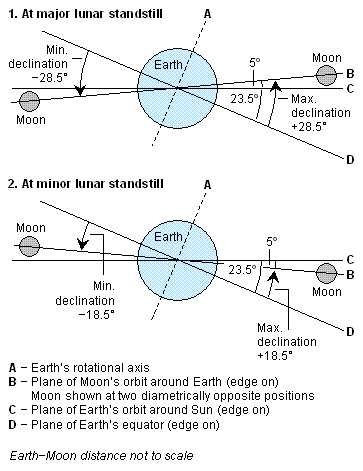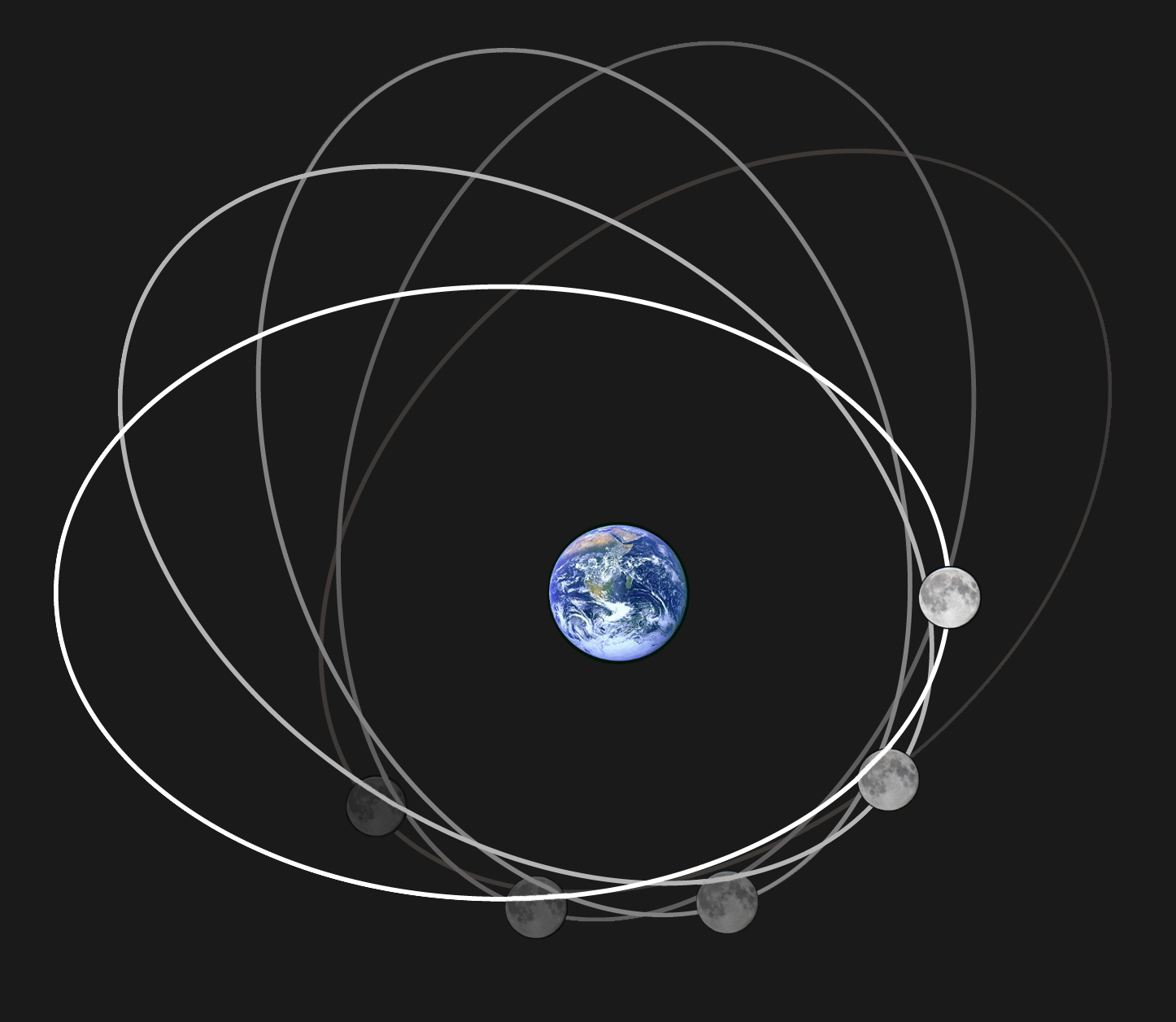Lunar Precession on:
[Wikipedia]
[Google]
[Amazon]
 Lunar precession is a term used for three different
Lunar precession is a term used for three different
 This kind of precession is that of the major axis of the Moon's
This kind of precession is that of the major axis of the Moon's
 Another type of lunar orbit precession is that of the plane of the
Another type of lunar orbit precession is that of the plane of the
precession
Precession is a change in the orientation of the rotational axis of a rotating body. In an appropriate reference frame it can be defined as a change in the first Euler angle, whereas the third Euler angle defines the rotation itself. In othe ...
motions related to the Moon
The Moon is Earth's only natural satellite. It is the fifth largest satellite in the Solar System and the largest and most massive relative to its parent planet, with a diameter about one-quarter that of Earth (comparable to the width of ...
.
First, it can refer to change in orientation of the lunar rotational axis with respect to a reference plane
In celestial mechanics, the plane of reference (or reference plane) is the plane used to define orbital elements (positions). The two main orbital elements that are measured with respect to the plane of reference are the inclination and the longi ...
, following the normal rules of precession
Precession is a change in the orientation of the rotational axis of a rotating body. In an appropriate reference frame it can be defined as a change in the first Euler angle, whereas the third Euler angle defines the rotation itself. In othe ...
followed by spinning objects.
In addition, the orbit of the Moon
The Moon orbits Earth in the prograde direction and completes one revolution relative to the Vernal Equinox and the stars in about 27.32 days (a tropical month and sidereal month) and one revolution relative to the Sun in about 29.53 days (a s ...
undergoes two important types of precessional motion: apsidal and nodal.
Axial precession
The rotational axis of the Moon also undergoes precession. Since the Moon's axial tilt is only 1.5° with respect to theecliptic
The ecliptic or ecliptic plane is the orbital plane of the Earth around the Sun. From the perspective of an observer on Earth, the Sun's movement around the celestial sphere over the course of a year traces out a path along the ecliptic again ...
(the plane of Earth's orbit
Earth orbits the Sun at an average distance of 149.60 million km (92.96 million mi) in a counterclockwise direction as viewed from above the Northern Hemisphere. One complete orbit takes days (1 sidereal year), during which time Earth ...
around the Sun), this effect is small. Once every 18.6 years, the lunar north pole describes a small circle around a point in the constellation Draco
Draco is the Latin word for serpent or dragon.
Draco or Drako may also refer to:
People
* Draco (lawgiver) (from Greek: Δράκων; 7th century BC), the first lawgiver of ancient Athens, Greece, from whom the term ''draconian'' is derived
* ...
, while correspondingly, the lunar south pole describes a small circle around a point in the constellation Dorado
Dorado () is a constellation in the southern sky. It was named in the late 16th century and is now one of the 88 modern constellations. Its name refers to the dolphinfish (''Coryphaena hippurus''), which is known as ''dorado'' in Spanish, altho ...
. Similar to Earth, the Moon's axial precession is westwards - whereas Apsidal precession is in the same direction as the rotation (meaning apsidal precession is eastward).
Apsidal precession
 This kind of precession is that of the major axis of the Moon's
This kind of precession is that of the major axis of the Moon's elliptic orbit
In astrodynamics or celestial mechanics, an elliptic orbit or elliptical orbit is a Kepler orbit with an eccentricity of less than 1; this includes the special case of a circular orbit, with eccentricity equal to 0. In a stricter sense, it ...
(the line of the apsides from perigee
An apsis (; ) is the farthest or nearest point in the orbit of a planetary body about its primary body. For example, the apsides of the Earth are called the aphelion and perihelion.
General description
There are two apsides in any ellip ...
to apogee
An apsis (; ) is the farthest or nearest point in the orbit of a planetary body about its primary body. For example, the apsides of the Earth are called the aphelion and perihelion.
General description
There are two apsides in any ellip ...
), which precess
Precession is a change in the orientation of the rotational axis of a rotating body. In an appropriate reference frame it can be defined as a change in the first Euler angle, whereas the third Euler angle defines the rotation itself. In othe ...
es eastward by 360° in approximately 8.85 years. This is the reason that an anomalistic month
In lunar calendars, a lunar month is the time between two successive syzygies of the same type: new moons or full moons. The precise definition varies, especially for the beginning of the month.
Variations
In Shona, Middle Eastern, and Euro ...
(the period the Moon moves from the perigee to the apogee and to the perigee again) is longer than the sidereal month
In lunar calendars, a lunar month is the time between two successive syzygies of the same type: new moons or full moons. The precise definition varies, especially for the beginning of the month.
Variations
In Shona, Middle Eastern, and Euro ...
(the period the Moon takes to complete one orbit with respect to the fixed stars). This apsidal precession
In celestial mechanics, apsidal precession (or apsidal advance) is the precession (gradual rotation) of the line connecting the apsides (line of apsides) of an astronomical body's orbit. The apsides are the orbital points closest (periapsi ...
completes one rotation in the same time as the number of sidereal months exceeds the number of anomalistic months by exactly one, after about 3,233 days (8.85 years).
Nodal precession
Moon's orbit
The Moon orbits Earth in the retrograde and prograde motion, prograde direction and completes one orbital period, revolution relative to the March Equinox, Vernal Equinox and the fixed stars, stars in about 27.32 days (a tropical month and sider ...
. The period of the lunar nodal precession is defined as the time it takes the ascending node
In general, a node is a localized swelling (a "knot") or a point of intersection (a vertex).
Node may refer to:
In mathematics
*Vertex (graph theory), a vertex in a mathematical graph
*Vertex (geometry), a point where two or more curves, lines, ...
to move through 360° relative to the vernal equinox (autumnal equinox in Southern Hemisphere). It is about 18.6 years and the direction of motion is westward, i.e. in the direction opposite to the Earth's orbit around the Sun if seen from the celestial north. This is the reason that a draconic month
In lunar calendars, a lunar month is the time between two successive syzygies of the same type: new moons or full moons. The precise definition varies, especially for the beginning of the month.
Variations
In Shona, Middle Eastern, and Europ ...
or nodal period
The nodal period (or draconic period) of a satellite is the time interval between successive passages of the satellite through either of its orbital nodes, typically the ascending node. This type of orbital period applies to artificial satellites, ...
(the period the Moon takes to return to the same node in its orbit) is shorter than the sidereal month. After one nodal precession period, the number of draconic months exceeds the number of sidereal months by exactly one. This period is about 6,793 days (18.60 years).
As a result of this nodal precession, the time for the Sun to return to the same lunar node, the eclipse year
A year or annus is the orbital period of a planetary body, for example, the Earth, moving in its orbit around the Sun. Due to the Earth's axial tilt, the course of a year sees the passing of the seasons, marked by change in weather, the hour ...
, is about 18.6377 days shorter than a sidereal year
A sidereal year (, ; ), also called a sidereal orbital period, is the time that Earth or another planetary body takes to orbit the Sun once with respect to the fixed stars.
Hence, for Earth, it is also the time taken for the Sun to return to the ...
. The number of solar orbits (years) during one lunar nodal precession period equals the period of orbit (one year) divided by this difference, minus one: − 1.
The precession cycle affects the heights of tides. During half the cycles the high and low tides are less extreme in the other half of the cycle they are amplified with high tides greater than average and low tides lower than average.
See also
*Lunar theory Lunar theory attempts to account for the motions of the Moon. There are many small variations (or perturbations) in the Moon's motion, and many attempts have been made to account for them. After centuries of being problematic, lunar motion can now ...
* Orbit of the Moon
The Moon orbits Earth in the prograde direction and completes one revolution relative to the Vernal Equinox and the stars in about 27.32 days (a tropical month and sidereal month) and one revolution relative to the Sun in about 29.53 days (a s ...
References
* {{DEFAULTSORT:Lunar Precession Orbit of the Moon